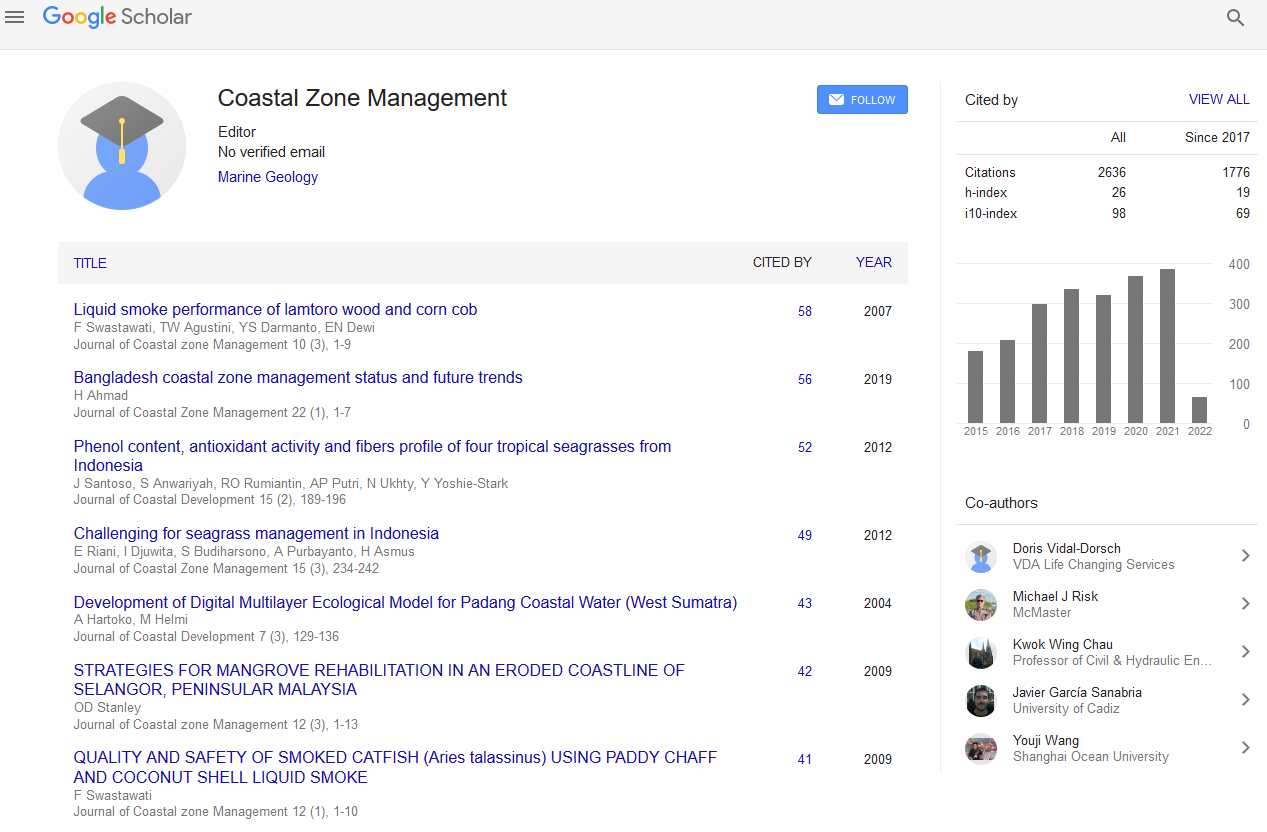Indexed In
- SafetyLit
- RefSeek
- Hamdard University
- EBSCO A-Z
- OCLC- WorldCat
- Publons
Useful Links
Share This Page
Journal Flyer

Open Access Journals
- Agri and Aquaculture
- Biochemistry
- Bioinformatics & Systems Biology
- Business & Management
- Chemistry
- Clinical Sciences
- Engineering
- Food & Nutrition
- General Science
- Genetics & Molecular Biology
- Immunology & Microbiology
- Medical Sciences
- Neuroscience & Psychology
- Nursing & Health Care
- Pharmaceutical Sciences
Marine biodiversity in India with special reference to conservation, status and issues
3rd International Conference on Coastal Zones and Oceanography
May 18-19, 2018 Singapore
Sainudeen Sahib
Sree Narayana College Kollam, India
Keynote: J Coast Zone Manag
Abstract:
India has a vast coastline of 8000 km, of which 5,423 km belong to Peninsular India and 2,094 km to the Andaman and Nicobar and Lakshadweep Islands and with an EEZ of 2.02 million sq. km. There are about 13,000 recorded marine species in India. Indian coastal zones have a variety of habitats like mangrove, estuarine, coral reefs, sea grass beds, lagoons, sand dunes, rocky shore, cliffs, intertidal mud flats, etc. Coastline of India has also supports nearly 250 million people and the ecological services of marine and coastal ecosystems of India play a vital role in India’s economy growth. The marine floral diversity includes 844 species of marine alga (sea weeds) belonging to 217 genera, 14 species of sea grasses and 69 species of mangroves. The marine faunal diversity includes a wide variety of life forum. The Indian coastal water harbors 451 species of sponges, more than 200 species of corals, more than 2900 species of crustacean, 3370 species of marine molluscs, more than 200 species of bryozoans, 765 species of echinoderm, 47 species of tunicates, more than 1300 marine fishes, 26 species of sea snakes, 5 species of sea turtles and 30 species of marine mammals including dugong, dolphins, whales, etc. In addition, a wide variety of sea birds can be observed around the coast. There are ten species of sharks and rays including whale shark, all species of sea horses, all cetaceans, dugong, nine species of shells, five species of sea turtles, one species of otter, all species of corals, all species of sponges and all holothurians that occur in coastal and marine areas of India are considered under threat, therefore, protected under the Wildlife (Protection) Act, 1972 by listing them in the Schedule. Major anthropogenic direct drivers of ecosystem degradation and destruction include habitat conversion to other forms of land use, overexploitation of species and associated destructive harvesting practices, spread of invasive alien species, and the impacts of pollution from agricultural, domestic and industrial effluents. In this paper, the major issues related to coastal and marine biodiversity conservation and measures taken to address them have been highlighted.
Biography :
Sainudeen Sahib is an Environmental Scientist, Science Manager, Educator, Author, Editor and Communicator. Considering his research work and environmental awareness program among public NASA and International Astronomical Union (IAU) had named a minor planet after his name called ‘Pattazhy planet 5178’ in 2008. He has acclaimed wide recognition among global scientific community through his research and has 300 publications, which include scientific papers, reports of research projects as well as science articles in newspapers to his credit. He has also authored more than 15 books internationally. He has been Member of Ministry of Environment and Forests, Government of India to study possible impacts of mobile towers; Expert Member of Indian Council of Medical Research to study impacts of mobile phones on living organisms; Expert Member of Kerala State Wildlife Advisory Board and Expert Member of Environmental Impact Assessment Authority. Email:
sainudeenpattazhy@hotmail.com
